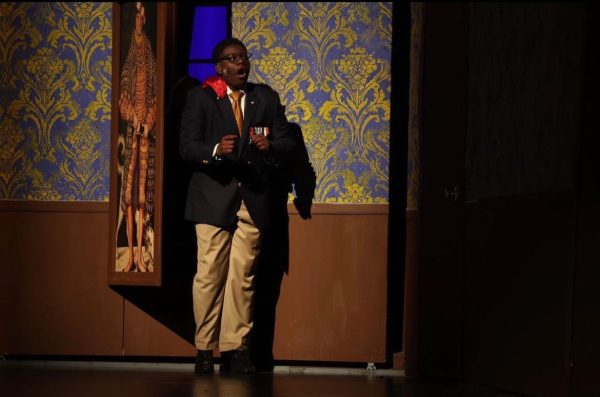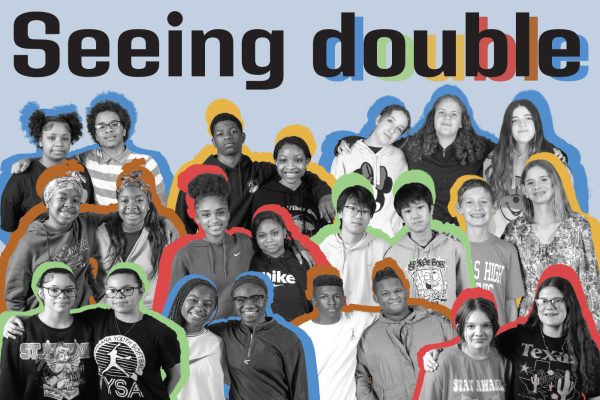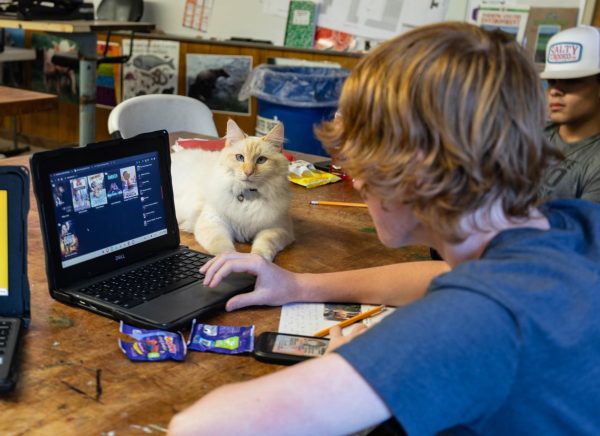The dress code doesn’t bite
Two friends are frustrated with the dress code and administration wants to reassure them
The school dress code has long been a topic met with debate and frustration.
December 10, 2020
The school dress code has long been a topic met with debate and frustration. To students discontent with dress code, it never fails to leave them feeling ashamed and angry. To them, it may feel like teachers get a kick out of chewing students out and any article of clothing is fair game, like ripped jeans, which are notorious for leaving girls’ thighs stinging with duct tape adhesive.
The discontent with dress code stems from its perceived unfairness and gender bias, mainly among girls. Seniors Christian Rogers and Peyton Sims didn’t expect a friendly fashion photoshoot to result in a bout with the question of the dress code’s equity.
As an editor-in-chief for publications, Sims is usually busy shooting candids of students all over campus or modelling her friends for a photoshoot. On the morning of Sept. 22, it was business as usual for her. Working in the photography studio, she conducted a fashion photoshoot in which model Rogers sported a trendy pair of ripped black jeans.
That inconspicuous denim carried a heavy backstory — just a few weeks earlier, Sims got dress coded for wearing that exact pair of jeans to school. After the shoot, Rogers wore them for the rest of the school day.
Did he get dress coded just like Sims did? The results were far from optimal: throughout an entire day of school, not to mention walking past the same administrator who had reproached Sims, Rogers didn’t have a single word spoken to him about the jeans.
“I walked by [a teacher] probably three times and [she] didn’t bat a single eye,” Rogers said.
Obviously, there’s this double standard. It’s very frustrating the fact that Peyton can wear these jeans and get dress coded for them. I’m a guy, and I can wear these jeans.
— Christian Rogers, 12
Both Sims and Rogers expressed frustration about the incident. Rogers believes the way dress code is enforced is hypocritical.
Sims showed worry about the practical side of this unfairness. She said there’s no point to having rules if they are not going to be equally enforced.
“If anything is going to be implemented with the dress code it should be fair, because if it’s not, I don’t see what it’s doing,” Sims said. “It’s more sexist than anything.”
They’ve seen this hypocrisy and double standard many times throughout school. They believe that certain people can get away with dressing outside of the policy.
“[I’ve] never even seen a guy get dress coded before,” Rogers said. “Guys who have [super short] athletic shorts never get dress coded for them.”
When asked to comment on the dress code’s strictness, Rogers said certain clothing items should simply be out of the question.
“I think you should be able to wear ripped jeans because no [student] cares at all,” Rogers said. “It’s the same thing with off the shoulder shirts and tank tops. [Administration] make[s] a big deal out of it.”
Sims believes it infringes on autonomy.
“As long as nothing insanely revealing is going on, I don’t see the problem,” Sims said. “I feel like outfits have to do with someone’s expression and comfort. It’s crazy to me how if a girl wants to wear leggings because she doesn’t feel like wearing jeans, administrators will follow her and dress code her.”
The disenchantment Rogers, Sims and many other students feel with the dress code is no old news. However, no one has tried to speak up about this issue that leaves so many frustrated and disheartened. Sims suggests that students should take initiative and express their concern with dress code.
“I think that they, as a student body, should start standing up and addressing what they think the problem is. Maybe [through] board meetings, making petitions and just talking to administrators firsthand,” Sims said.
Students are disillusioned with the dress code because they believe it is enforced unfairly and that it lacks a purpose. Principal Carla Dupree wants to make it clear that this is not the case. She says the dress code serves a practical yet crucial purpose: preparing students for professional expectations past high school.
“The purpose of you guys being in high school is to prepare you for when you get out of high school,” Dupree said. “The majority of you are going to be going into careers, where you will be in a professional setting. [That setting] could be an office area, it could be welding, it could be some sort of public service, [like] police officers or sales. When you look at that as our purpose, it also reinforces the fact that we should teach you there is an appropriate way to dress in a particular setting.”
Dupree wants to make sure students leave high school understanding the importance of appearance within professional settings.
I want you to understand, when you walk across that stage, how you should look for an interview, if you have to go present in front of a committee [or] if you have to go to court. It’s not saying that one way is the right way to dress and one way is the wrong way to dress. It’s saying to consider your setting.
— Carla Dupree, Principal
Dupree was unaware that students think dress code enforcement is biased. She assures that administrators do not purposely enforce the rules with bias in mind and that the dress policies’ perceived inequity is merely circumstantial.
“When guys walk by us in the hallway, just as we don’t know what you’re going through in that moment, you don’t know what we’re dealing with,” Dupree said. “If I’m sitting there and don’t have anything on my mind, it’s easy for me to scan and look for dress code [violations]. If I just left something that broke my heart or a confrontational situation, my mind might not be in that moment. It’s a great possibility that maybe that admin person wasn’t scanning at that moment [Rogers did not get dress coded].”
She also noted that the percentage of males who wear ripped jeans is significantly lower than that of females. When coupled with an administrator’s unawareness in a given moment, the result is that a boy unintentionally doesn’t get dress coded. The situation is to blame, not bias.
“First of all, the percentage of young men who wear jeans with holes in them is less,” Dupree said. “Secondly, sometimes admin may or may not be tuned in. So if you’re in the male population, you’ve got holes in your jeans and you walk by an admin, it’s a great possibility that maybe that admin wasn’t scanning at that moment.”
Lastly, Dupree wants to help her students. Whether that means pointing out a rip above fingertip length, teaching essential academic skills or just listening to students, she assures that administration does everything they can to be forgiving and helpful.
“This morning, we had a situation,” Dupree said. “Belly showing, holes in the jeans. [I asked], ‘Can you call somebody to bring you something?’ [The student replied], ‘My mom’s at work.’ [I explained], ‘This is an issue; we need to have somebody bring something.’ We ended up helping out with a pair of leggings for that, but next time it’ll be ISS, because we don’t have an unlimited supply of clothes. I don’t want [you] in ISS for dress code. I want you in classes, but we have to have some sort of guidelines.”
Dupree says students’ feelings about dress code hadn’t been addressed because she was unaware of them, but he wants them to know that she is receptive to their concerns.
“I love it that you guys talk to me,” Dupree said. “I love that we have this relationship. I listen to you. It doesn’t mean that I’ll always change the way we do things, but I love to know. I had no idea that y’all felt there was an inequity [among] male and females [with the] dress code.”





















